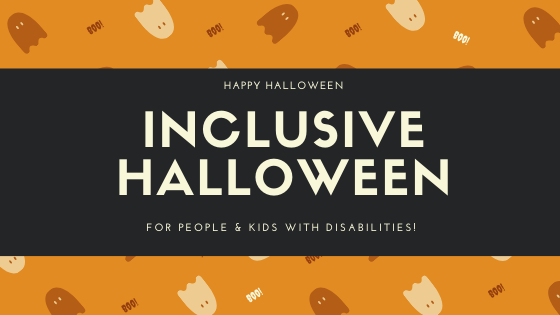
How to have an Inclusive Halloween
Halloween is probably second only to Christmas on the list of favorite holidays. It’s full of candy, costumes, and more candy, so what person wouldn’t like it? But for people with disabilities, it might not have the same allure. As a person with a disability or parent of a child with a disability, your brain may have to work in overdrive to problem-solve issues like how to make the perfect, functional Halloween and where the accessible Trick-or-Treat route is. But the clock hasn’t struck midnight, so don’t turn into a pumpkin just yet. Let us help you create a healthy, fun, and fully inclusive Halloween for everyone to enjoy!
Below are 5 ways to make Halloween inclusive for kids with disabilities.
- Take it downstairs: If your house has steps, set up a lawn chair at the bottom of the stairs (or in your garage if it’s cold!). That way kids who use wheelchairs or have a tough time with the stairs can still say trick or treat.
- Consider non-edible treat options: Some kids with special needs can’t eat by mouth and use feeding tubes. Others may have sensory issues with food or be on strictly controlled diets for health/allergy reasons. It is helpful to have a bucket of non-edible goodies for kids. Bubbles, Playdoh, pencils, notepads, and stamps are all inexpensive options that most kids would love! If you’re feeling particularly festive, participate in the Teal Pumpkin Project to show that you have non-edible treats to give out.
- Don’t insist kids say "trick-or-treat": Some kids with disabilities can’t talk. Others may require an extra moment to process before they speak or respond. Instead of insisting that all kids say trick-or-treat and unintentionally singling out a child with challenges, try commenting about wonderful costumes or smiles.
- Be patient: We know it’s cold, or rainy or even snowy, but please be patient. A lot of kids with special needs need an extra moment or two to fully participate.
- Don’t single out kids with disabilities: You might admire a child who is struggling to walk, but try not to single them out for this. It’s totally fine to tell them they did a great job, but be sure to say something about their costume, the loot they are collecting or anything that doesn’t have to do with their disability.
Remember to be accepting. There is a picture going around Facebook that states:
Keep in mind the child who is grabbing more than one piece of candy may have poor fine motor skills. The child who takes forever to pick out one piece of candy may have motor planning issues. The child who does not say trick or treat or even thank you may be non-verbal. The child who looks disappointed when they see your bowl might have an allergy or is diabetic. The child who isn’t wearing a costume at all might have a sensory issue (SPD) or autism. Be nice & be patient.
Lastly, Connecting For Kids also has a how-to guide for host an inclusive Halloween. Listing everything from sensory concerns, to removing obstacles for equal access!

*The article "7 Ways To Make Halloween Inclusive For Kids With Disabilities" was written by Anchel Krishna.
